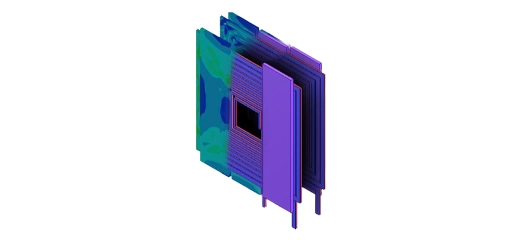Electric Conduction Analysis
Electric Conduction in EMWORKS?
- Electric conduction analysis is essential for understanding current flow in conductive materials.
- With built-in professional CAD, EMWORKS offers an accessible simulation platform, enabling engineers to streamline workflows and enhance design productivity.
- Simulates pathways, resistance, and energy dissipation to help engineers create efficient and reliable systems.
- Focuses solely on conductors that sustain continuous current flow, unlike electrostatic analysis.
- Provides insights for material selection, circuit design, and power distribution to optimize performance and cost-effectiveness.
Key Features of EMWORKS Electric Conduction Analysis
Comprehensive Current Flow Simulation
Electric Conduction Analysis within EMWORKS offers a comprehensive suite of tools for simulating current flow, enabling precise analysis and optimization of electrical conduction pathways.
User-Friendly Interface
EMWORKS provides an intuitive graphical interface designed to facilitate ease of use. Access to extensive training materials via a demo viewer ensures that engineers and designers can quickly become proficient in electric conduction analysis.
Parametric Simulation
Engineers can explore the impact of various geometric and simulation parameter variations on their designs, gaining invaluable insights into how these factors affect current distribution and conduction behavior.
Current Distribution Calculation
Electric Conduction Analysis in EMWORKS allows for the calculation of current distribution within conductive materials. This feature is essential for assessing the efficiency and performance of conductors, ensuring they meet design specifications.
Resistance Calculation
EMWORKS provides tools to compute the resistance of conductive elements, aiding in the evaluation of electrical circuits and systems.
Power Loss Analysis
With Electric Conduction Analysis, engineers can analyze power losses within conductors, helping optimize designs for efficiency and reduced energy consumption.
Heat Generation Prediction
Predicting heat generation in conductive materials is crucial for ensuring safe operating conditions and thermal management. EMWORKS enables engineers to assess and mitigate potential heat-related issues.
Customized Design Scenarios
The ability to define user-defined scenarios empowers engineers to simulate and analyze a wide range of real-world situations, enabling them to make informed design decisions.
Broad Range of Applications
Electric Conduction Analysis is applicable to various industries and scenarios, including power converters, cables, busbars, connectors, printed circuit boards, and more, ensuring its versatility and relevance across different domains.
Efficiency and Cost Savings
By facilitating early identification and resolution of design issues related to electric conduction, EMWORKS contributes to efficiency gains and cost savings in product development and optimization processes.
Seamless Integration
EMWORKS seamlessly integrates with computer-aided design (CAD) software, allowing for the effortless incorporation of electric conduction analysis into the overall design workflow.
Realistic and Reliable Results
The robust analytical and finite element-based solvers employed by EMWORKS ensure that engineers can trust the accuracy and reliability of the results obtained during electric conduction analysis.
By offering these key features and benefits, Electric Conduction Analysis in EMWORKS equips engineers and designers with the necessary tools to optimize conductive systems, enhance electrical performance, and ensure the reliability and safety of their products and designs.
Applications of Electric Conduction Analysis
Electric Conduction Analysis, a powerful capability within EMWORKS , offers engineers and designers the tools to design, model, and analyze a wide range of devices and equipment operating within conductive media. Here is a comprehensive overview of the devices and equipment that can benefit from Electric Conduction Analysis:
Power Converters
Electric Conduction Analysis is instrumental in the design and analysis of power converters, ensuring efficient current flow, minimizing power losses, and optimizing impedance matching for applications such as DC-DC converters and inverters.
Cables
In the realm of electric wiring and cabling, Electric Conduction Analysis helps assess the current distribution and resistance along cables, guaranteeing reliable power transmission and minimizing voltage drops.
Busbars
Engineers can use Electric Conduction Analysis to design busbar systems for power distribution, ensuring uniform current distribution and minimizing hot spots, thereby improving the efficiency and safety of electrical systems.
Connectors
Connectors play a critical role in electronic systems. Electric Conduction Analysis helps evaluate connector designs for optimal current-carrying capacity and low contact resistance.
Printed Circuit Boards (PCBs)
Electric Conduction Analysis is invaluable for PCB design, helping to optimize the layout of traces and vias, assess impedance matching, and reduce power losses due to resistive elements.
Resistors
Electric Conduction Analysis enables the precise modeling and analysis of resistive components in electrical circuits, ensuring their performance and heat dissipation characteristics are optimized.
Fuses
Electric Conduction Analysis helps assess the behavior of fuses in electrical circuits, ensuring they operate reliably under overcurrent conditions while protecting the circuit.
Shunts
For accurate current measurement and control applications, Electric Conduction Analysis assists in the design and evaluation of shunt resistors to ensure precise current sensing.
Solar Cells
In the renewable energy sector, Electric Conduction Analysis is essential for modeling and optimizing the electrical behavior of solar cells to maximize energy harvesting efficiency.
Electronic Circuits
Electric Conduction Analysis is employed extensively in the design and analysis of electronic circuits, ensuring proper current distribution, impedance matching, and minimizing power losses.
Biological Medium
In biomedical applications, Electric Conduction Analysis aids in understanding the electrical behavior of biological tissues and the design of devices like electrodes and sensors for medical diagnostics and treatment.
Hardening
For applications where materials need to be hardened, Electric Conduction Analysis is used to optimize the electrical processes involved, such as induction hardening or electron beam hardening.
Anodizing
In the field of surface treatment, Electric Conduction Analysis helps optimize the anodizing process, ensuring uniform coatings and corrosion resistance in various industries.
Conductive Structures
In various industries, conductive structures such as enclosures, chassis, and frames require precise analysis to prevent electromagnetic interference (EMI) and maintain grounding integrity. Electric Conduction Analysis ensures proper current distribution and low impedance paths.
Electromagnetic Shields
Electric Conduction Analysis aids in designing effective electromagnetic shields by modeling the behavior of conductive shielding materials and assessing their ability to block or redirect electromagnetic interference.
Connective Components
Components like connectors, terminals, and contactors need to be analyzed for optimal electrical performance. Electric Conduction Analysis helps in evaluating contact resistance, current-carrying capacity, and heat generation.
High-Current Systems
Systems involving high current levels, such as electric vehicles (EVs), electric propulsion systems, and industrial machinery, benefit from Electric Conduction Analysis to ensure safe current flow and manage heat dissipation.
Switchgear
Electric Conduction Analysis is vital for the design and analysis of switchgear equipment in electrical distribution systems, guaranteeing reliable current interruption and preventing overheating.
Transformers
In power distribution and generation systems, transformers require careful analysis to optimize winding designs and minimize energy losses. Electric Conduction Analysis aids in assessing core and winding performance.
Electric Machines
Electric motors and generators depend on precise current distribution within windings and conductive components. Electric Conduction Analysis ensures efficient power conversion and minimizes losses.
Semiconductor Devices
Electric Conduction Analysis plays a role in optimizing semiconductor devices like diodes and transistors by analyzing their electrical characteristics and ensuring proper heat dissipation.
Battery Systems
Electric Conduction Analysis is used to design and assess battery systems, including battery packs for electric vehicles, to ensure even current distribution among cells and manage temperature rise.
Power Distribution Networks
Large-scale power distribution networks, such as those in data centers or smart grids, require comprehensive analysis to ensure uniform current distribution and minimal power losses.
Renewable Energy Systems
Electric Conduction Analysis helps optimize electrical components in renewable energy systems, such as wind turbines and solar inverters, to maximize energy harvesting and reduce losses.
Electrical Grids
Analysis of the electrical grid infrastructure, including substations and transmission lines, ensures
These diverse applications underscore the indispensable role of Electric Conduction Analysis in enhancing safety, performance, and efficiency across numerous industries, from aerospace and healthcare to manufacturing and energy. The precise management of current flow, impedance, power losses, and heat generation is paramount in modern technology and infrastructure, and Electric Conduction Analysis serves as an essential tool in achieving these objectives.
Results of Electric Conduction Analysis
The Electric Conduction Analysis provides a comprehensive set of results for each study, including:
Electrostatic Potential
Understanding the electric potential at different points within the conductive system.
Electric Field
Identifying the strength and direction of the electric field throughout the conductive medium.
Electric Flux Density
Measuring the distribution of electric flux within the analyzed system.
Power Loss
Quantifying the amount of power dissipated as heat due to resistance in the conductors.
Resistance
Evaluating the opposition to current flow in the conductive materials.
Stored Energy
Assessing the energy stored within the conductive system.
Temperature
Estimating the temperature distribution within the conductive elements.
Temperature Gradient
Analyzing how temperature varies across the conductive components.
Heat Flux
Understanding the rate of heat transfer within the conductive system.
These results provide crucial insights into the behavior of conductive materials, aiding in the optimization of electrical systems, heat management, and overall performance enhancement.



